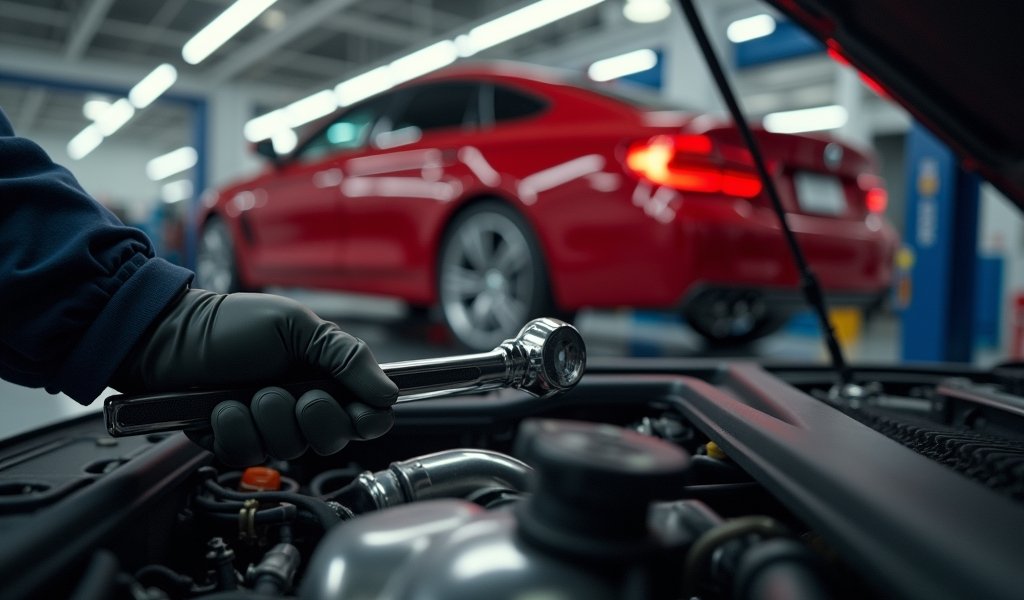Overview
This article explains the importance of regular PCV valve replacement for vehicle maintenance, recommending replacement every 30,000 miles under normal conditions or every 15,000-20,000 miles under severe conditions. It details the valve’s function in regulating engine pressure, warning signs of failure, step-by-step DIY replacement instructions, maintenance tips to extend valve life, and cost comparisons between DIY ($25) versus professional service ($60-$165).
Table of Contents
- Understanding the PCV Valve: What It Does and Why It Matters
- 5 Warning Signs Your PCV Valve Needs Replacement
- Recommended PCV Valve Replacement Schedule: Manufacturer Guidelines vs. Reality
- DIY PCV Valve Replacement: A Step-by-Step Guide
- 5 Essential Tips to Extend Your PCV Valve’s Lifespan
- Cost Considerations: DIY vs. Professional Replacement
- Conclusion
- Frequently Asked Questions
Understanding the PCV Valve: What It Does and Why It Matters
Let’s talk about that little component under your hood that rarely gets attention until things go wrong – the PCV valve. Your vehicle’s Positive Crankcase Ventilation (PCV) valve is one of those unsung heroes of engine performance and longevity. As a mechanic who’s seen countless engines damaged by neglected PCV systems, I can tell you that understanding the pcv valve replacement schedule is crucial for maintaining your vehicle’s health.
The PCV valve performs a seemingly simple but vital function. It regulates the flow of gases that build up in your engine’s crankcase during normal operation. These gases, if left unchecked, can create pressure that leads to oil leaks, decreased performance, and eventually, serious engine damage. Think of it as your engine’s pressure relief valve and filtration system rolled into one.
What makes the PCV valve special is its elegance – it’s a small, spring-loaded device that opens and closes based on engine vacuum, allowing just the right amount of gases to be recycled through the positive crankcase ventilation system. These gases then get burned during normal combustion rather than building up or being released into the atmosphere.
Over time, the PCV valve can become clogged with oil sludge and carbon deposits. When this happens, it may stick in either the open or closed position, disrupting the delicate pressure balance in your engine. The results can range from minor performance issues to significant engine damage if left unaddressed.
While often overlooked during routine maintenance, establishing a proper pcv valve replacement schedule is essential preventive maintenance that can save you from costly repairs down the road. The good news is that PCV valves are relatively inexpensive (typically $5-$25 for the part) and, on many vehicles, fairly straightforward to replace. It’s one of those small investments that yields significant returns in engine longevity.
5 Warning Signs Your PCV Valve Needs Replacement
Your engine has ways of telling you when the PCV valve is failing, but you need to know what to look for. Here are the top five signs that it’s time for a replacement, regardless of your regular pcv valve replacement schedule:
- Increased oil consumption: If you’re topping up your oil more frequently between changes, a stuck PCV valve might be allowing excessive crankcase pressure to push oil past seals and gaskets.
- Rough idle or stalling: When the valve sticks open, it creates a vacuum leak that disrupts the air-fuel mixture, causing erratic idling or even stalling at low RPMs.
- Check engine light: Modern vehicles monitor vacuum systems closely. A failing PCV valve often triggers the check engine light, typically with codes related to lean running conditions or vacuum leaks.
- Oil leaks: Excessive crankcase pressure from a clogged PCV valve can force oil past gaskets and seals, creating visible leaks around your engine.
- Sludge buildup: During your oil changes, if you notice increased sludge in your oil or around the oil cap, it could indicate poor crankcase ventilation due to a failing PCV valve.
I remember working on a customer’s Ford F-150 that had developed mysterious oil leaks around the valve covers. The owner had already replaced the valve cover gaskets twice with no improvement. When I checked the PCV valve, it was completely clogged with sludge. A simple $10 replacement solved what had become a frustrating and expensive problem.
Don’t ignore these symptoms. A failing PCV valve can lead to reduced fuel efficiency, decreased performance, and in severe cases, premature engine wear. According to CarMD’s vehicle health index, ignoring emission-related issues like PCV valve failures can lead to an average repair cost increase of 30% if secondary problems develop.

Recommended PCV Valve Replacement Schedule: Manufacturer Guidelines vs. Reality
When it comes to establishing a pcv valve replacement schedule, there’s often a gap between manufacturer recommendations and what I’ve seen works best in the real world. Most manufacturers suggest replacing the PCV valve every 20,000 to 50,000 miles, though some modern vehicles stretch this to 60,000 miles or more.
These guidelines sound straightforward, but the reality is that your optimal replacement interval depends heavily on your driving habits and conditions. Here’s what affects your PCV valve’s lifespan:
- Driving style: Frequent short trips where the engine never fully warms up accelerate PCV valve deterioration due to increased condensation and sludge formation.
- Climate: Extremely cold environments can cause moisture to freeze in the valve, while high-temperature regions may cause oil to break down faster and clog the valve.
- Oil change frequency: Regular oil changes with high-quality oil help reduce sludge that can clog your PCV system.
- Age of vehicle: Older engines typically produce more blow-by gases, putting additional strain on the PCV valve.
- Engine condition: Worn engines with compromised piston rings create excessive crankcase pressure, shortening PCV valve life.
Based on my experience working with hundreds of vehicles, I recommend a more conservative approach than many manufacturers. For vehicles driven under normal conditions, replacing the PCV valve every 30,000 miles is a good baseline. However, if you frequently drive in stop-and-go traffic or take many short trips, consider inspecting it every 15,000-20,000 miles.
For high-mileage vehicles (over 100,000 miles), I’d recommend an even more aggressive replacement schedule—every 15,000 miles or during every other oil change. The minimal cost of replacement ($5-25 for most vehicles) is cheap insurance against the problems a failed PCV valve can cause.
Research from SAE International studies shows that proper crankcase ventilation can extend engine life by reducing acid formation and oil contamination. When you consider that a new engine can cost thousands of dollars, the few minutes and dollars spent on PCV maintenance seem like an obvious choice.
DIY PCV Valve Replacement: A Step-by-Step Guide
One of the most satisfying aspects of PCV valve maintenance is that on many vehicles, it’s a beginner-friendly DIY job. Here’s a straightforward guide to help you stick to your pcv valve replacement schedule without a trip to the mechanic:
Tools You’ll Need:
- New PCV valve (ensure it’s the correct one for your vehicle)
- Basic hand tools (pliers or socket set, depending on your vehicle)
- Shop rags
- Penetrating oil (for stubborn connections)
- Safety glasses
Step-by-Step Replacement Process:
- Make sure your engine is cool before beginning work.
- Locate the PCV valve. On most engines, it’s connected to the valve cover by a rubber grommet or hose. Consult your owner’s manual if you have trouble finding it.
- Disconnect any hoses attached to the valve, noting their position for reassembly.
- Remove the old valve by gently pulling or twisting it out of its grommet. Some valves may require pliers or a socket, but be careful not to damage the grommet.
- Inspect the removed valve. A properly functioning valve should rattle when shaken. If it doesn’t, it’s definitely time for replacement.
- Check the hoses and grommets for signs of deterioration. This is an excellent time to replace these inexpensive components if needed.
- Install the new valve by pushing it firmly into place, ensuring it seats properly.
- Reconnect any hoses you removed, making sure they’re secure.
- Start the engine and check for proper operation. Listen for any unusual noises or vacuum leaks around the valve.
The entire process typically takes 15-30 minutes, even for novices. For some vehicles, it’s as simple as unplugging the old one and plugging in the new one. Others might require removing an engine cover or reaching into a tight space, but it’s still well within the capabilities of most DIYers.
I once helped a customer who had been quoted $150 for a PCV valve replacement on his Toyota Camry. We bought the part for $8, and I showed him how to do it in his driveway in less than 10 minutes. He was amazed at how simple it was and felt empowered to take on more basic maintenance tasks himself.
Remember that while the replacement itself is straightforward, properly diagnosing PCV issues isn’t always obvious. If you’re experiencing symptoms but aren’t sure if the PCV valve is the culprit, a quick test is to remove the oil filler cap while the engine is idling. If you feel strong suction, the PCV system is likely working. Little or no suction could indicate a problem with the valve or related components.
5 Essential Tips to Extend Your PCV Valve’s Lifespan
While following a regular pcv valve replacement schedule is important, there are several things you can do to maximize your valve’s lifespan and ensure optimal engine performance between replacements:
1. Follow a Rigorous Oil Change Schedule
Regular oil changes with high-quality oil are your first line of defense against PCV valve failure. Fresh oil reduces sludge buildup that can clog the valve. I recommend synthetic oils for most vehicles, as they resist breakdown better than conventional oils, especially in extreme temperatures. For most modern vehicles, changing oil every 5,000-7,500 miles provides a good balance between protection and economy.
2. Use Fuel System Cleaners Periodically
Quality fuel system cleaners can help reduce carbon deposits that might find their way into your PCV system. I suggest using a good cleaner every 3,000-5,000 miles, especially if you notice hesitation or rough idling. These products help keep your entire intake system cleaner, indirectly benefiting your PCV valve by reducing overall contamination.
3. Avoid Excessive Short Trips
Short trips where your engine never fully warms up are particularly hard on PCV valves. The incomplete combustion creates more contaminants while condensation doesn’t get a chance to evaporate. When possible, combine errands to allow your engine to reach full operating temperature. If your driving patterns necessarily include many short trips, consider a more aggressive pcv valve replacement schedule.
4. Perform Regular Valve Cover Gasket Inspections
Oil leaks from valve cover gaskets can seep into the PCV valve, accelerating its deterioration. During oil changes, visually inspect the valve cover gaskets for signs of leakage. Addressing these leaks promptly not only protects your PCV valve but prevents more extensive engine contamination.
5. Consider Periodic PCV System Cleaning
For high-mileage vehicles or those operated in dusty conditions, consider a complete PCV system cleaning every 60,000 miles. This involves removing and cleaning not just the valve but also the associated hoses and passages. Professional-grade solvent cleaners designed specifically for PCV systems can be used, though this is typically best left to professionals unless you’re comfortable with more involved engine work.
I’ve seen firsthand how these preventive measures can dramatically extend component life. A customer with a Jeep Wrangler came in with 200,000+ miles on the original PCV valve. The valve was still functioning because he followed a rigorous maintenance schedule, including full-synthetic oil changes every 5,000 miles and occasional use of EPA-recommended fuel system cleaners.

Cost Considerations: DIY vs. Professional Replacement
Sticking to your pcv valve replacement schedule doesn’t have to break the bank. Let’s break down the costs so you can make an informed decision about DIY versus professional service:
DIY Replacement Costs:
- PCV valve: $5-$25 for most vehicles (some luxury or specialty vehicles may be more)
- Tools: Minimal if you have basic hand tools
- Time investment: 15-30 minutes for most vehicles
- Total DIY cost: Typically under $25
Professional Replacement Costs:
- Parts: $5-$25 (same as DIY)
- Labor: $50-$120 (varies by location and vehicle type)
- Shop supplies/fees: $5-$20
- Total professional cost: $60-$165
The significant cost difference makes PCV valve replacement one of the most economical DIY maintenance tasks you can perform. Even if you’ve never turned a wrench before, this is an excellent entry-level project to build your confidence.
That said, there are scenarios where professional replacement makes sense. If your vehicle’s PCV valve is difficult to access (buried under multiple components), or if you’re uncomfortable working on your vehicle, the professional route ensures proper installation. Additionally, a mechanic can perform a more comprehensive check of related systems during the service.
One cost factor often overlooked is the diagnostic aspect. If you’re experiencing symptoms that might be related to a faulty PCV valve but aren’t certain, a professional can accurately diagnose the issue. I’ve seen customers spend money replacing parts based on guesswork, only to find the real problem was elsewhere.
Remember that the true cost analysis should include the potential savings from preventing more expensive problems. Regular PCV valve replacement, whether DIY or professional, helps avoid oil leaks, reduced fuel economy, and even catastrophic engine damage in extreme cases. When you factor in these potential savings, the modest cost of replacement becomes one of the best values in automotive maintenance.
Conclusion
Establishing and following a proper pcv valve replacement schedule is one of those maintenance tasks that delivers outsized benefits relative to its cost and effort. This humble valve plays a crucial role in maintaining your engine’s health, performance, and longevity, yet it’s often overlooked until problems arise.
Based on decades of experience working with all types of vehicles, I recommend replacing your PCV valve every 30,000 miles under normal driving conditions, with more frequent replacements (every 15,000-20,000 miles) for vehicles subject to severe conditions like frequent short trips, extreme temperatures, or high-mileage engines.
The beauty of PCV valve maintenance is its accessibility. For most vehicles, it’s an inexpensive part and a straightforward DIY job that takes less than 30 minutes. Even if you opt for professional service, it remains one of the most cost-effective maintenance procedures available.
Remember that your driving habits, environment, and vehicle specifics all impact the optimal replacement interval. Listen to your engine – unusual noises, excessive oil consumption, rough idling, or oil leaks might be your PCV valve asking for attention before your scheduled replacement.
By incorporating PCV valve replacement into your regular maintenance routine, you’re making a small investment that protects your engine’s health and your wallet. It’s one of those rare win-win scenarios in automotive maintenance – inexpensive, relatively simple, and tremendously beneficial.
Frequently Asked Questions
How often should I replace my PCV valve?
Most manufacturers recommend replacing the PCV valve every 20,000-50,000 miles. For optimal engine protection, I recommend every 30,000 miles for normal driving conditions and every 15,000-20,000 miles for severe conditions.
What happens if I don’t replace my PCV valve?
A failing PCV valve can cause oil leaks, reduced fuel economy, rough idling, and increased emissions. In severe cases, it can lead to engine sludge buildup and premature engine wear.
How much does it cost to replace a PCV valve?
The part typically costs $5-$25, with DIY replacement taking 15-30 minutes. Professional replacement ranges from $60-$165, including parts and labor.
Can I clean my PCV valve instead of replacing it?
While cleaning is possible with solvents, replacement is recommended due to the low cost of new valves. Cleaning may temporarily improve function but won’t restore a worn valve to factory specifications.
Will a bad PCV valve trigger the check engine light?
Yes, a failing PCV valve often triggers the check engine light, typically with codes related to lean running conditions or vacuum leaks. Modern engine management systems are sensitive to the changes in air-fuel mixture caused by PCV problems.

